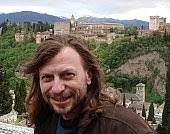inside a calligraphy that effaced them and pointed to infinity,
regardless of what I or any other poet could have inscribed
within characters flowing out in currents of curls and loops,
our gilded vessels flourishing forth aglow with ancient light.
Envision the knots in polychrome tiles that framed these verses
and countless more swirled out here in a script whose letters
cognized as geometry when images failed to describe the world.
Blink. Shift your vision from flat crystallized squares--
turning sideways to cubes, then merging out of depth into octagons--
to a minute scale of witnessing. Eyeball blue, black, green tesserae,
like the rows of color pixels sprayed on the television screen
that you notice when you get up close and don't look through them
at the flicker synchronized with a scramble of voices.
Somehow these bits that tessellate along points, lines and planes
reveal how the walls they swarmed came to simulate a cosmos.
Gaze up at the starry roof. Don´t pretend my words matter there.
Language in time, prayer's isomorphs, this room: It's your own.
The Room That Recurs.
______
'The Room That Recurs,' a perfect title for this poem on the calligraphies of our souls etched on Islamic tiles in Sufi mystical lettering that bursts and disappears like sparks leaving phosphorescent trails in the air. A divine alphabet, "characters flowing out in currents..." glow of "ancient light." A history of the written word implied in the sweep of the poem, a poetry of the word: "a script whose letters/ cognized as geometry when images failed to describe the world." This in the sacred geometry of our recurring 'room': our perception, the "gilded vessel" of our bodies' consciousness.
As if viewing images of tiles in the Alhambra, zooming in until they are single pixels of colour without defined shape, "from flat crystallized squares" to "turning sideways cubes, then merging out of depth into octagons," on the "minute scale of witnessing" we see "Eyeball blue, black, green tesserae."
On the microscopic planes, we are in the abstraction of our lives of form.
The poetic vision shifts from standing before an art that effaces its makers for a vision of "infinity," from the rarefied past to the ubiquitous television screen.
When we arrive at the pixelated world of the screen and its moving images it's perhaps different, perhaps not. Look through the narratives, the stories transmitted through the medium to the nature of the screen itself, "the rows of color pixels sprayed," the "synchronized" "scramble of voices."
These "bits that tessellate along points, lines and planes" swarm to "simulate a cosmos" that may or may not be an entrance into reality any more than the Islamic temple of calligraphy that is art.
"Gaze up at the starry roof," the dome of stars. Our language swirls in time's unwinding even as our humble poem to the universe is an isomorphic prayer.
Inhabit your room (your dwelling space, where the energy of life and consciousness comes to reside) of light.
We inhabit ourselves.
When we open our perceptions to our calligraphies, scripts to limn the world.
Cosmic vision. Infinity in an azulejo, a pixel. Holographs, "prayer's isomorphs."
An affirmative and beautiful poem.
(And one of my favourite of John's poems.)

John F. Walter

Decorative Tiles,' or Azulejos, Alhambra, Granada, Spain



Your comment not only fully sheds light on every surface of the Pythagorean-Abrahamic geometric forms I started with and the finite recursive limits of the tessellated individual consciousness I pointed to, but represents a poem in its own right, Brenda.
ReplyDeleteAs you know, The Room That Recurs is just a fractal figment, an algorithmic fragment,
an instantiated word-holon, and a self-replicating 'azulejo' in its own right of a much larger poem (at this juncture, seventy eight double spaced pages and growing like any crystalline structure with its own encoded structuring intelligence and iota of chaos.
And so I may have to ask you, my friend and fellow pre-Sim collaborator, later on for permission to add this comment of yours to the preface when I publish the integral 'poemario' book that " M.C. Escher In The Alhambra" is becoming through trial and error, the secretion of occult formulas.
For now, I can only sit back on my sofa, move the computer screen a metre further away from my own line of sight, and marvel at the splendid way you've framed my framing of infinity.
Since I just saw Orhan Pamhuk an hour ago, who is the ultimate oriental literary game player in the mandarin tradition that spans the Andalusian poets, The Arabian Nights, J.L. Borges, Italo Calvino and the Latin American magical realists, all of this meta-inscription seems not only right and just--in the sense of Scheherezade telling a brand new tale a thousand and one times, or the same story 1001 different ways, depending on your point of view or proximity to the emir's bed in the heart of the harem--but also, something you and I did together a long time ago, before I knew I could write, before we both knew we could read and write and share our minds as second selves.
Love & Affection,
John
YES.. very nice of you Brenda to give your poetry aficionados a sneak preview of what will prove to be a ground-breaking work on the mutable nature of art, its chameleon-like utterance into our psyche and consciousness, its power and its beauty and perhaps most of all, its mystery.
ReplyDeleteRich weaving of poetry, art, and fecund minds instills a delicious frisson of collaborations to come.
ReplyDeleteYum.